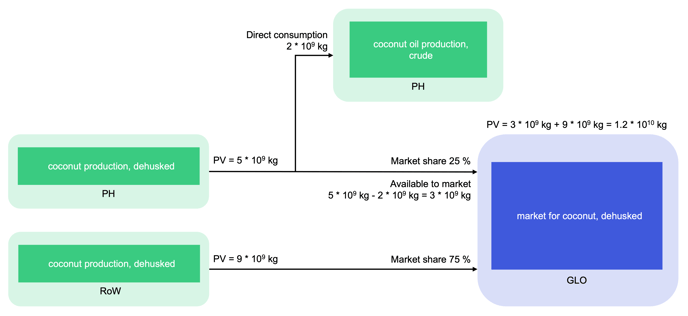P
Parameter
Represents different types of values used in a dataset and defined by the data provider. The new ecoSpold2 data format allows the use of formulas to calculate the amounts of flows and other entities in the datasets. For example, the yield of chemical reaction can be inserted in the dataset as a parameter.
Parent Dataset
A dataset referred to by a child dataset as the dataset from which field values in the child dataset are to be inherited to the extent defined, i.e. parent datasets serve as basis of their associated child datasets. Only geographical inheritance is allowed in the ecoinvent version 3 database, i.e. some regional datasets (such as Brazilian soybean production) might be modeled as a child dataset of the global dataset. In child datasets values can be set to relate to the corresponding value in the parent dataset. When such a related value is changed in the parent dataset it is automatically changed in the child dataset as well.
PM10
Abbreviation for particulate matter with a diameter of less than 10 µm
PM2.5
Abbreviation for particulate matter with a diameter of less than 2.5 µm
Process
A term used in ecoinvent version 2 which was replaced in ecoinvent version 3 by the more generic term activity. Process represents set of interrelated or interacting activities that transforms inputs into outputs (ISO 14040).
Process Water
Water used by a process excluding cooling water. In most cases, process water is in contact with the product. This water does not include incorporated water in inputs used by the process.
Produced Water
This can occur in the case of some chemical reactions.
Product
Good or service output of a human activity with a positive either market or non-market value. While in ecoinvent version 2 the product name was identical with the activity name, in ecoinvent version 3 the product name is independent from the activity name. For example in ecoinvent version 2 “chloroacetic acid, at plant” is a name for both the activity and the product. The same dataset in ecoinvent version 3 is called “chloroacetic acid production” which produces the product called “chloroacetic acid.”
Product Water Content
This is the flow from another process in the system (technosphere flow). Every product has water content and therefore can be used to balance the water flows. This is especially important for water transport and treatment processes (e.g. water supply and waste water treatment). The product water content is presented in the ecoinvent version 3 database via the water in wet mass property.
Production Mix
The production-volume-weighted average of the suppliers of a specific product within a geographical area.
Production Volume
Production volume is the amount of a product (reference and potentially by-product) generated within the system boundaries of the activity. In treatment activities, the production volume of the reference product represents the amount of the waste treated within the given system boundaries. The production volume is expressed in the same unit as the product (for example, kg or kWh).
All transforming datasets include data on the production volume in the given geographical area. Production volumes are always annual values.
When more than one activity produces the same product within the same geographical area, the production volume of each activity reflects that activity alone, i.e., the production volumes are additive.
Production volumes are used to determine the market compositions. In each market activity, the inputs are modeled as originating from all transforming activities within the geographical area of that market activity. These transforming activities produce the market reference product as an output and supply the market in proportion to their available production volume (i.e., the production volume of the market = total production volume of the supplying transforming activities – direct consumption by the consuming transforming activities via an activity link). See the graphic below for reference.
Property
Every exchange (both elementary and intermediate) with a mass can have a number of properties. For example, every product currently present in the database has at least the following properties; wet mass, dry mass, water in wet mass, water content, carbon content, fossil and carbon content, non-fossil.